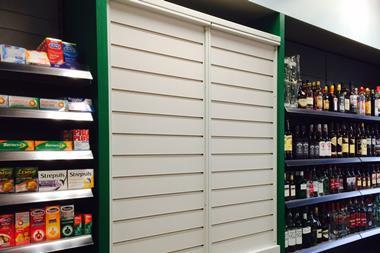The year ahead will be a defining one for the UK’s tobacco category. The tobacco display ban on 6 April will force a dramatic change in the way retailers tackle tobacco - requiring them to become true category experts, up to speed with latest local and national trends and NPD.
One trend that retailers will have to keep on top of is value for money. “When the display ban arrives, some consumers may ask for the cheapest tobacco product,” says James Higgs, head of marketing and public affairs at Scandinavian Tobacco Group UK. The group is endeavouring to position Salsa RYO as the cheapest on the market, gram for gram, by making it available in half outers of 5x12.5g packs, retailing at £3.49 each.
Sitting at the sharp end of the value-for-money drive, Roll Your Own (RYO) sales are continuing to grow at more than 8% year on year, and the category is now worth more than £2bn. In fact, a third of the cigarettes smoked in the UK are now RYO, according latest JTI data.
Unsurprisingly, the lower-priced end of the market is where most recent npd has been channelled, and this is not expected to change in 2015.
Priming itself for increased demand for lower-priced products JTI relaunched B&H Silver RYO, with a new price point late last year, while Imperial Tobacco introduced JPS RYO in a new 9g pouch for just £2.99.
THE RULES
What you can do under the new legislation:
● Open the unit to retrieve one or more products if a customer asks for information about a tobacco product
● Open the unit to assess stock levels or to restock the unit
● Open the unit in response to a request from an adult, even if they are accompanied by a child
● Open the unit for any form of repair, maintenance or cleaning
● Display one A3 tobacco products price list poster anywhere in store. The poster must have wording no larger than size 30 font and contain only the brand name, price and number of units per pack
● Keep a product catalogue at each point of sale, but not on display unless requested by a person over 18.
What you can’t do:
● Open the unit at the request of a person under the age of 18. If in doubt always ask for ID before opening the gantry
● In England, Wales and Scotland you can’t open the unit to retrieve or display anything other than tobacco products. Accessories and lighters must be stocked outside the gantry. In Scotland the rules are different and all accessories must be covered inside the gantry.
Meanwhile, with much of the growth in the 20-25g RYO segment being driven by papers-in-pouch offerings, BAT upgraded Pall Mall 20g to include papers last year.
Imperial is also anticipating 2015 to be “another great year” for its new economy cigarette brand L&B Blue. It also lowered the rrp of its Carlton range to £6.25 for packs of 19 cigarettes in February, while Carlton 10s fell to £3.25.
Along with its impact on what you sell, the biggest effect of the tobacco display ban will be the way you sell cigarettes, rolling tobacco, cigars and accessories.
While about 70% of convenience stores are thought to be having their gantries made compliant by either JTI or Imperial Tobacco by the 6 April deadline, the remaining 30% are going it alone.
If you are one of the 30% and you still haven’t finalised your plans for covering up, or booked in a date for an alternative solution to be fitted, you need to get your skates on.
Cover-ups
The rules do not prescribe how you cover your unit as long as tobacco is obscured completely and the maximum display area is not exceeded when you retrieve products.
In England, Wales and Northern Ireland the maximum display area is 1.5sq m, but in Scotland it is 1,000sq cm (roughly the length of 8-12 pack facings).
Another key difference is that in England, Wales and Northern Ireland, accessories such as papers and filters can continue to be displayed in public view. This means that they cannot be kept behind sliding door or curtains in the tobacco gantry as it will be an offence to display tobacco products when serving customers with accessories.
However, in Scotland the opposite is true. The retail display ban includes tobacco accessories, meaning that papers, filters, cigarette holders and pipes must be hidden behind the gantry doors. However, this does not include lighters, matches or electronic cigarettes.
For those yet to choose which solution they install, there are plenty of options, from sliding doors and overhead units to under-counter draws and automated gantries (see panel above). But provided your gantry does not exceed 1.5sq m you can also use your current roller blinds to conceal tobacco - but only if they do not feature any tobacco-related logos or branding.
However, tobacco law expert Helen Jenkins advises against this as a long-term solution. “They can be cumbersome and were not designed for ease of access as they are a security feature. This may work as a temporary measure, but I’m not sure it is robust enough to endure the amount of opening and shutting that will be required. Retailers also have a duty of care in respect of their employees’ health and safety so they should use this method with caution,” she says.
A thick curtain would also be compliant - provided the 1.5sq m permitted display was never exceeded and tobacco was not visible from the sides.
Staff training
Along with the structural changes comprehensive staff training is also essential - not only to keep you and your staff on the right side of the law, but also to ensure that customer service doesn’t suffer. STG’s James Higgs explains: “Talking staff through where the products will be merchandised ahead of time will also allow them to get used to where they’re positioned and reduce transaction times at the till as a result.”
Budgens retailer David Knight has worked closely with his local Trading Standards officer to devise a comprehensive staff training programme before his store went dark. “I invited our local Trading Standards team to come in and go through the legislation with us. I then wrote my own staff training paper and asked them to validate it, which they did. Building up that relationship with them prior to the ban was important to me and should stand us in good stead in the future,” he says.
Training staff to have a more detailed understanding of the brands stocked and a heightened understanding of general and local tobacco sales trends will also be of benefit, says BAT’s acting head of business development Richard Wood.
“When the doors go up, retailers will become true tobacco category managers as adult smokers are anticipated to ask them more questions because they cannot immediately see the range of choice within the category. Training all of your staff to understand which tobacco products are premium or value for money, which product is the lowest price on the gantry and which products are American blend or Virginia Blend will help them to serve adult customers,” he adds.
David Knight agrees, and as a result has also introduced specialist teams to manage the tobacco category. “Staff that work on the tobacco kiosk tend to be full time and have become category specialists, able to talk to shoppers about the range that we now stock,” he explains.
Spar retailer Paul Stone had doors fitted to his gantry in Oxford Road back in February, giving him time to help staff get up to speed.
“Staff training has been crucial and going dark ahead of the deadline has certainly helped as they are now all very well versed in where all the brands are located.
“JTI has fitted the doors. It’s actually a very clever solution from JTI’s point of view. All the JTI brands have been ranged in the top half of the gantry, behind their own set of doors, while all the Imperial, PML and STG brands are together down at the bottom. If a customer requests a JTI brand they only see JTI brands when that section of the gantry is opened and no other products from any of the other manufacturers,” he says.
Communicate the changes
Don’t leave it till 6 April to start explaining the dark market legislation to your adult tobacco shoppers - unless you want to slow up service and create long debates over the counter.
STG’s Higgs urges retailers to put their shoppers at the heart of their plans. “Retailers are in danger of focusing only on preparing their store and forgetting about their customers,” he says.
“It’s crucial they engage with customers early so they understand the changes and the reasons for them. By educating customers, as well as staff, retailers can ensure a smoother transition for their store into the dark market.”
It’s a lesson that David Knight learned the hard way when his large Budgens store in Hassocks, West Sussex, went dark in 2012.
“The first major problem that we encountered after implementing the display ban was confused shoppers. As there had been next to no communication about the ban from the Department of Health, many customers didn’t believe that the ban was a genuine legal requirement. They thought that it was my policy and I received a number of letters of complaint. People even wrote to Budgens’ Head Office complaining about me!
“With hindsight I should have done much more to communicate the change to shoppers. We made the mistake of focusing wholly on internal compliance and forgot the shopper entirely, which is a cardinal sin for a convenience store.
“Confused shoppers also led to significant delays at the till as staff had to spend time explaining to angry adult smokers. In the end we had to ensure that all three tills were continuously manned, even at quieter times of the day, to try to mitigate the queues. My advice to all retailers is start telling your shoppers now, learn from my mistake, and don’t leave it till the last minute.
“There are lots of things you could do, from simply telling each tobacco shopper what’s coming up, to using in-store posters and POS to say that a change is coming.”
Today’s Local Stokenchurch retailer Rishi Madhani had a similar experience when his store in Buckinghamshire went dark last month. “Staff received lots of questions from customers in the first few weeks and there was quite a bit of confusion as most shoppers thought that it was only the large stores and supermarkets that needed to go dark. Only a few knew that it was about to impact on small stores, too.”
In Holsworthy, Devon, Premier retailer Dan Cock produced a fact sheet, which he has been handing out to his regular adult smokers. “The fact sheet puts their minds at ease and explains why we are having to do this. Half of our customers had no idea small stores would have to comply with the tobacco display ban,” he says.
In Thames Ditton, Surrey, Manny Patel’s customers will be well versed in what to expect when his gantry is fitted with JTI sliding doors this month. “I’ve been telling my customers about the display ban for some time now. The education process has gone hand in hand with my range rationalisation. I’ve been cutting back on slow sellers and some 10-packs for some time now in preparation for the ban and telling my customers why as I’ve done it,” he explains.
Availability issues
One key learning to emerge from Australia, as well as large UK convenience stores and supermarkets, is that availability suffers in a display ban environment.
Just ask David Knight, who says that managing availability was a key challenge when his large store went dark. “At first we kept on running out of stock. Once the staff and managers couldn’t see the tobacco, they just forgot about it. One Sunday when we were closed I happened to open up the gantry and was horrified to find it almost empty. It turned out that staff had forgotten to replenish it, or even place a new order for two days.
“It took us about four months to figure out how to rework the gantry. In the end we introduced a very strict mandate on gap checks with availability checked every two hours,” he says.
Imperial head of independent retail Andrew Miller urges retailers to “place an increased focus on analysing market data”. He says identifying sales patterns will help to avoid out of stocks when display restrictions are enforced.
“Getting into the habit of carrying out regular availability checks and marking key lines off on a checklist now will make the transition far smoother in April,” he adds.
“Retailers should also consider placing reminder cards on autofeeds so that staff are aware of what product goes in each space, and keep a customer request book for new products,” he adds.
The penalties for non-compliance with the new legislation are severe. Any person, including shop managers and shop assistants, found guilty is liable - on summary conviction in a magistrates court - to: a fine not exceeding £5,000, or imprisonment for a term not exceeding six months, or both; OR, on conviction on indictment in the Crown Court, to imprisonment for a term not exceeding two years, a fine, or both.
However, be reassured that the Department of Health (DoH) and Trading Standards Institute alike are likely to take a more educational approach to enforcement for the first few weeks following 6 April. A spokeswoman for the DoH recently told Convenience Store that “no retailer will be penalised on 6 April” when the ban on open displays comes into force.
“Trading Standards will work with retailers over a reasonable amount of time to help them become compliant if they are not already,” she added.
Tony Allen from training company Underage Sales says that he expects most Trading Standards officers (TSOs) to provide help and advice for the first six weeks post-implementation. But he warns: “Local authorities vary and there are some who will take a much more hard-line approach and enforcement action straight away.
“They are likely to be particularly tough on breaches that relate to underage sales and unlawful displays to people under the age of 18.
“And no matter what the local authority, I would expect a serious and concerted bout of test purchasing operations across the UK this summer,” he adds.
Range
The tobacco display ban requires retailers to think in much greater detail about their range - with many placing a much keener emphasis on top sellers. But as Today’s retailer Rishi Madhani explains, getting it right doesn’t happen overnight.
“Our gantry went dark a few weeks ago and we found out quite early on that the planogram wasn’t working as well as it should have been. Fortunately, we had the time to make changes and give our top 10 lines the facings that they deserved, while cutting back on some of the much slower sellers. In my opinion, if a tobacco product hasn’t sold for more than four weeks you probably shouldn’t be stocking it. We’ve only kept those slow-selling brands that we know for sure our regular customers bought occasionally and the good news is that sales have not dropped at all.”
Londis retailer and STG UK Gantry Guardian Raj Aggarwal urges retailers to conduct range reviews as a matter of urgency to iron out problems and give staff time to get used to the new plan: “Change your range now to suit your customers’ needs and keep it that way so your staff can get used to serving your customers from certain positions,” he says.
“That way, when it goes dark, your staff will already be familiar with where they are and you won’t put customers off with lengthy waits at the till.”
Cleaning maintenance
Doors can be opened for cleaning and maintenance, but be warned: if you say that you are cleaning the gantry, you must be actively doing it, Tony Allen adds. “Don’t open the doors and then go and get the cleaning products: they need to be with you from the start. Quite a few of the supermarkets got into trouble for things like this in the early days.”
CASE STUDY
Automatic gantries in action
Nisa retailers Jamie and Anish Keshwara are reaping the benefits of having an automated tobacco gantry fitted in their Broad Street store in Whittlesey, Cambridgeshire.
The gantry is supplied by Navarra Retail Systems and was installed with the help of the store’s epos provider MSP Epos Systems. Linked to the store’s till, staff can serve customers their brands of choice at the press of a button - with packs taking just a second to be dispensed. A prompt on the till system also reminds staff to check for ID before packs are dispensed.
“Not only is the gantry display ban compliant and more secure than sliding doors or other solutions, it also allows us full stock control,” Jamie says.
A 1.5m automated gantry costs about £5,000, however there are lease finance options available.
Independent retailer Susie Hawkins has had a 1.2m automated gantry fitted in her new Spar forecourt in Highworth, near Swindon. “The gantry is so easy to use and is far more secure. In fact, my insurance company has just come to visit and I am expecting to see a drop in my premium as a result of having it,” she says.
The retailers say that automated gantries will also come into their own should standardised packaging come into force.
more information
Need further information? The Association of Convenience Stores (ACS) has a pictorial guide to the display ban on its website, www.acs.org.uk/advice.
The Department of Health has also produced a Q&A, which is being circulated at wholesalers and posted on the Business Companion website, www. businesscompanion.info/en/quick-guides/goods/display-and-sale-of-tobacco-products.
Your local Trading Standards officer should be able to advise you, too. Go to www.gov.uk/find-local-trading-standards-office to find your local office.
The UK’s tobacco manufacturers offer a wealth of advice. JTI’s new website, www.jtiadvance.co.uk, allows retailers access to key category insights, news on product developments and legislative information.
Imperial Tobacco has a new online platform which can be accessed via trade website www.imperial-trade.com, while BAT has lots of advice via its MOR£ programme and sales representatives.
STG, meanwhile, has produced a number of Gantry Guardians’ Guide to Tobacco handouts, available via sales reps, or by emailing enquiries.uk@st-group.com.
PREVENTING UNDERAGE SALES IN A DARK MARKET
Once the tobacco display ban is implemented it will be illegal for any section of the gantry to be opened at the request of someone under the age of 18. From 6 April staff and store owners must carry out ID checks on anyone suspected of being under age BEFORE they select the tobacco product, or risk a stiff penalty.
Tony Allen, managing director of training company Underage Sales, explains: “The display ban completely changes the way in which retailers manage underage sales. At the moment retailers and staff have quite a lot of thinking time before making or refusing a tobacco sale. They have to find the product on the gantry, put it through the till and, in many cases, pass a till prompt. This new legislation changes all that - effectively there is no more thinking time in a dark market environment. As soon as anyone who might be underage asks for tobacco an ID check has to be carried out. Opening the gantry doors to someone under the age of 18 is an offence - even if you don’t sell them the product. In fact, opening the doors for someone under the age of 18 is an offence which can be punished with a fine of up to £5,000 - double the penalty for selling tobacco to someone under the age of 18. It’s absurd, but it’s true.
“Staff will not be able to rely on till prompts anymore. They will have to think about age-restricted goods in much more detail, and it can’t wait until 6 April; they need to be trained in this significant change now.”











![WG-4003[58]](https://d2dyh47stel7w4.cloudfront.net/Pictures/274x183/4/5/1/353451_wg400358_6083.jpg)











No comments yet